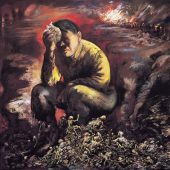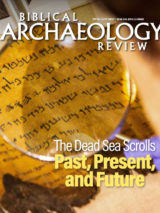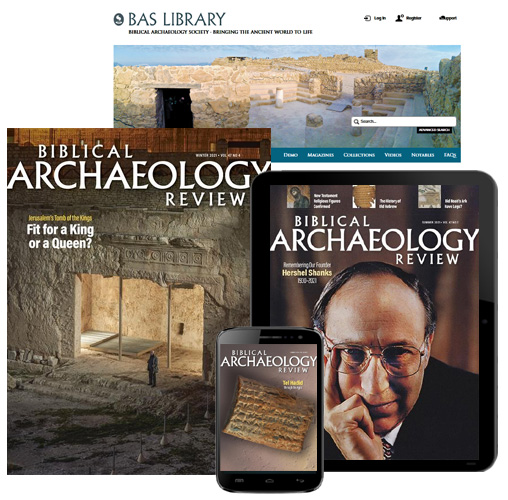Biblical Studies in the Digital Age
How digital archaeology has revolutionized Biblical studies

A fifth-century parchment containing Latin translations of the Book of Jubilees and the Testament of Moses. This manuscript is the subject of BAR columnist Todd R. Hanneken’s Jubilees Palimpsest Project. Photo: Jubilees Palimpsest Project.
New technologies have continuously been transforming the ways people live, communicate and learn. No segment of human experience seems to be immune to the trends in all-pervading digital technologies—not even scholarly disciplines as “serious” and “old-fashioned” as Biblical studies.
Despite its popular perception as a rather antiquarian field of study that people associate with a trowel and a notebook, archaeology in particular has recently adopted highly sophisticated tools, giving rise to subfields like digital archaeology and cyber archaeology. This doesn’t mean that we dropped traditional tools—time-tested methodologies, such as stratigraphic excavation, cannot be replaced. At the same time, however, the digital age gives scholars tools that supersede human abilities—in both retrieving and analyzing data. So although much of the collecting of archaeological data still happens in the dust and sweat of the outdoors, advanced, high-tech examination has moved to dimmed and cooled laboratory spaces.
So, what are these new digital tools, and what are their benefits?
Writing for Biblical Archaeology Review, digital archaeologist Todd R. Hanneken of St. Mary’s University in San Antonio, Texas, provides an expert overview of innovative technologies his team uses in studying an erased parchment manuscript (called a palimpsest) of the Book of Jubilees, an extra-Biblical Jewish religious work composed in mid-second century B.C.E.
Studies of badly preserved inscriptions and erased manuscripts, explains Hanneken, benefit most from advanced digital photography, namely from the so-called multispectral imaging and reflectance transformation imaging.
Multispectral imaging (MSI) copes with the simple fact that human color vision is limited—both in range (our eye cannot see ultraviolet and infrared light) and resolution (we see color in bands rather than a smooth gradient). This innate human deficiency can be remedied by the use of a camera equipped with sensors capable of capturing an extended spectrum of light, including the ultraviolet and infrared wavelengths. By finding the optimal wavelength, experts are now able to obtain images that “bring out” text that has been obliterated to the naked eye—whether it is a text intentionally deleted from a palimpsest or traces of naturally faded writing on ancient pottery.
Interested in the latest archaeological technology? Researchers at the UCSD’s Calit2 laboratory released the free BAS eBook Cyber-Archaeology in the Holy Land — The Future of the Past, featuring the latest research on GPS, Light Detection and Ranging Laser Scanning, unmanned aerial drones, 3D artifact scans, CAVE visualization environments and much more.
Reflectance transformation imaging (RTI), on the other hand, captures texture (shape) of an object by controlling the angle of light under which it is viewed. Even though a person could achieve a similar effect by simply turning the physical object in his or her hand, he or she would have to first secure access to the object. But what is more: reflectance transformation imaging combines dozens of images of the same object while moving only the angle of illumination with every new picture taken. And since these data exist digitally, they can be amplified or enhanced for better clarity and then combined into a single image (see image below). In the case of the Book of Jubilees palimpsest, this technology—aided by incredible spatial resolution of images—enables us to see texture as fine as the corrosion of ink on the parchment, which makes the erased letters visible again.

This building inscription from the citadel of ancient Amman, the capital of the Ammonites in modern Jordan, dates to the ninth century B.C.E. The top left photo taken with ambient, flat light is illegible. The top right photo taken with a low-angled, raking light using RTI technology shows the texture through highlights and shadows, rendering the text legible. The bottom images illustrate two more possible digital enhancements of the surface texture—diffuse gain (left) and specular enhancement (right). Photo: Courtesy USC West Semitic Research Project; photo by Heather Dana Davis Parker.
Hanneken’s Jubilees Palimpsest Project goes even further in that it takes advantage of the strengths of both reflectance transformation imaging and multispectral imaging, combining them into one interactive image set. Called spectral reflectance transformation imaging (Spectral RTI), this innovative practice provides data on both color (spectral signature) and texture (shape) of an object. (See palimpsest above and image below.)

The same section of an erased medieval manuscript (UCLA Rouse MS 32) is rendered here in accurate color (top) and Spectral RTI pseudocolor. Visible text reads Rogo te do[mine], “I entreat you, oh Lo[rd].” Photo: Courtesy of the Jubilees Palimpsest Project.
What all these new tools and technologies have in common is that they expand our human capacities to obtain data (e.g., to read what was impossible to read) and to effectively analyze and interpret them.
Another important aspect worth highlighting concerns the digital nature of the data acquired with these new tools. Digitally preserved data, such as enhanced images of manuscripts or inscriptions, can be easily replicated, transmitted and viewed—virtually by anyone, anytime and anywhere. This last aspect brings to the fore issues of openness of intellectual property. However touchy that subject might be, it is reasonable to assume that democratizing access to data benefits both those who wish to learn (students, the general public) and those who are actively involved with the research (scholars), regardless of their location.
To learn more about the technicalities and advantages of the new digital technologies that have been transforming research in Biblical studies and beyond, read Todd R. Hanneken’s Archaeological Views column “Digital Archaeology’s New Frontiers” in the March/April 2017 issue of Biblical Archaeology Review.
BAS Library Members: Read the full Archaeological Views column “Digital Archaeology’s New Frontiers” by Todd R. Hanneken in the March/April 2017 issue of Biblical Archaeology Review.
Not a BAS Library member yet? Join the BAS Library today.
Related reading in Bible History Daily:
Digital Humanities and the Ancient World
Archaeological Views: New Eyeballs on Ancient Texts
Ancient Military Correspondence: Send Wine
Archaeological Views: Pottery in the Computer Age
Digital Dead Sea Scrolls Reveal New Biblical Insights
Must-Read Free eBooks
Want more Bible history?
Sign up to receive our email newsletter and never miss an update.
All-Access Pass
Dig into the world of Bible history with a BAS All-Access membership. Biblical Archaeology Review in print. AND online access to the treasure trove of articles, books, and videos of the BAS Library. AND free Scholar Series lectures online. AND member discounts for BAS travel and live online events.
Subscribe Today











